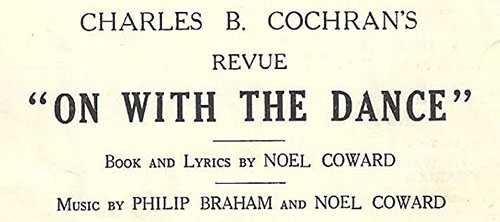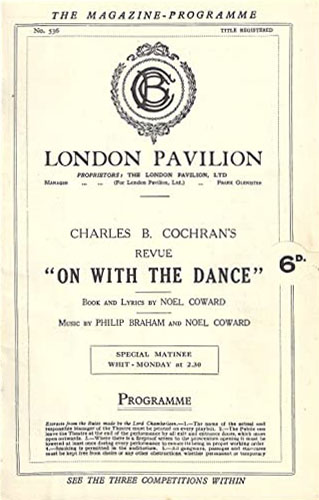
Les 22 scènes du spectacle étaient jouées par une énorme distribution qui a pris 27 heures pour finaliser la répétition générale du Try-Out à Manchester!
Noel Coward dit de cette revue: «...was lavish to a degree and very good in spots.» ou «Those three days in Manchester were on the whole unpleasant although fraught with incident. In the first place I discovered that my name was not on the bills at all. The show was labelled 'Charles Cochran's Revue,' which, considering that I had done three-quarters of the score, all the lyrics, all of the book and directed all the dialogue, scenes, and several of the numbers, seemed to be a slight overstatement. i went roaring back from the theatre to the Midland Hotel and attacked Cockie in his bathroom. i am not at all sure I did not deprive him of his towel while I shrieked at him over the noise of the water gurgling down the plug-hole. I will say however that he retained his dignity magnificantly, far more so than I, and in due course calmed me down and gave me some sherry. It is odd that in all of the years I have since worked with Cockie, that show was the only one over which we have ever quarrelled. i think the psychological explanation mnust be that then, in those early days of our association, we had neither of us estimated accurately enough our respective egos. And a couple of tougher ones it would be difficult to find.»
Coward a écrit ses chansons pour cetter alors qu’il jouait dans son premier succès, The Vortex (). En outre, 1925 est une année chargée pour Coward, dans laquelle il produit trois autres pièces à Londres: Fallen Angels (), Hay Fever () et Easy Virtue ().
Le spectacle a ouvert ses portes pour un Try-Out au Palace Theatre de Manchester, en Angleterre, le 17 mars 1925 et est transféré au London Pavilion, où il se joue durant 229 représentations.
Le spectacle a marqué pour Alice Delysia chantant Poor Little Rich Girl. Cochran voulait couper la pièce et a dû être dissuadé par Coward. En plus de Delysia, la distribution comprenait Hermione Baddeley, Ernest Thesiger, Nigel Bruce et Douglas Byng. Le soir de l’ouverture, Coward n’était pas encore le célèbre nom qu’il serait à la fin de l’année : La revue Manchester Guardian ne l’a mentionné qu’une seule fois, et la revue The Times ne l’a pas mentionné du tout.
Cosmopolitan lady
I'm so in love
Poor little rich girl
First love
Couldn't we keep on dancing?
Raspberry time in Runcorn
Spinsters' song
The vicarage dance
Choir boys' song
Even clergymen are naughty now and then
Church parade
Come a little closer
Aucun dossier informatif complémentaire concernant On with the Dance
Aucun dossier informatif complémentaire concernant On with the Dance

Version 1
On with the Dance (1925-11-London Pavilion-Londres)
Type de série: OriginalThéâtre: London Pavilion (Londres - Angleterre) Durée : 6 mois 2 semaines Nombre : Première Preview : Inconnu
Première: 30 April 1925
Dernière: 14 November 1925Mise en scène : Chorégraphie : Producteur : Star(s) : Avec: Nigel Bruce, Ernest Thesiger, Léonide Massine, Douglas Byng, Richard Dolman, Ernest Lindsay, Harry Barker, Emmett Baker, Lance Lister, Fred Winn, Terry Kendall, Donald Neville, Billy Reynolds, Jean Perrie, Kenneth Henry, Fred Wallace, Arthur Howe, Albert Zapp, Max Rivers, Victor Tunwell, Herbert Richards, Walter Gore, Jimmy Gilbert, Tom Hilary, Trocadero Four. Alice Delysia, Eleonora Marra, Hermione Baddeley, Betty Shale, Greta Fayne, Jessie Taylor, Violet Gould, Joan Nurick, Dolly Nepean, Helen Gardom, Dorothea Varda, Greta Beronius, Vera Bryer, Hettie Steer, Nancy Barnett, Nora Lorrimore, Terri Storri, Florence Desmond, Averil Haley, Decilia Mobray, Rita Robinson, Thalia Barberova, Peggy Heather, Amelia Allen, Josephine Head, Pat Kendall, Laurie Devine, Betty Oliver, Emma Williams, Enid Hudson, D’Soura Noranna.Presse : Stage said the revue was mixed in quality; while there were “brilliantly staged ballets and production numbers,” Noël Coward’s sketches were “mediocre when they [were] not unpleasant.”
The reviewer in The Sunday Times was not impressed, calling it "a curious mixture of perfect beauty and perfect drivel," with "not a good tune in the whole piece"
Whereas The Times critic responded more positively, noting that "as a whole, with the dancing always preponderating, the revue [was] excellent."
The Era's reviewer wrote on May 9, 1925, "The most comical thing in the revue is the Vicarage Garden Party on the lines of a musical comedy, with Miss Hermione Baddeley giving a clever and cruel burlesque of Nellie, the heroine, and Mr. Ernest Thesiger and Mr. Douglas Byng, as two clergymen, singing the funniest number of the evening."
The Morning Post (1 May 1925) says: "Mr Charles Cochran's new revue is at once the most decadent and most brilliant thing he has ever done. the whole thing is more than modern, bizarre, grotesque, fantastic, unnatrual. the speed of the change from scene to scene, of the performance of each number, is feverish, burlesquing the speed of opur overheated life. At times the players seem mad, intoxicated with the desire to force their bodies to do something faster, faster."
"As befits Mr. Coward's genius, many of the incidents are as nature seen through a glass crookedly, and when we see some normal little typical revue duet-dance face to face, it seems positively dull - an effort to restore the company to a state of mental balance. Those arid, futile people that Mr. Coeward puts into his plays dash about the stage, worked into afrenzy by the syncopated music."
"M. Massine, who produced the two amazing ballets, 'The Rake', suggested by engravings of Hogarth, and 'Crescendo', an attempt to 'shatter' the gentle tranquility of Les Sylphides by the insistent clamour of modernity - both left one gasping - danced briliantly. His resource is magnificent, his multiplicity of movement astonishing, his accuracy marvellous. But all of course, bizarre, preposterous, in so much that the beautiful stately 'Hungarian Wedding' with which the revue ended almost perished because the contrast was too great. The number at the end of the first part, 'Couldn't We Keep on Dancing?' should be taken as the finale."
Pas encore de video disponible pour ce spectacle